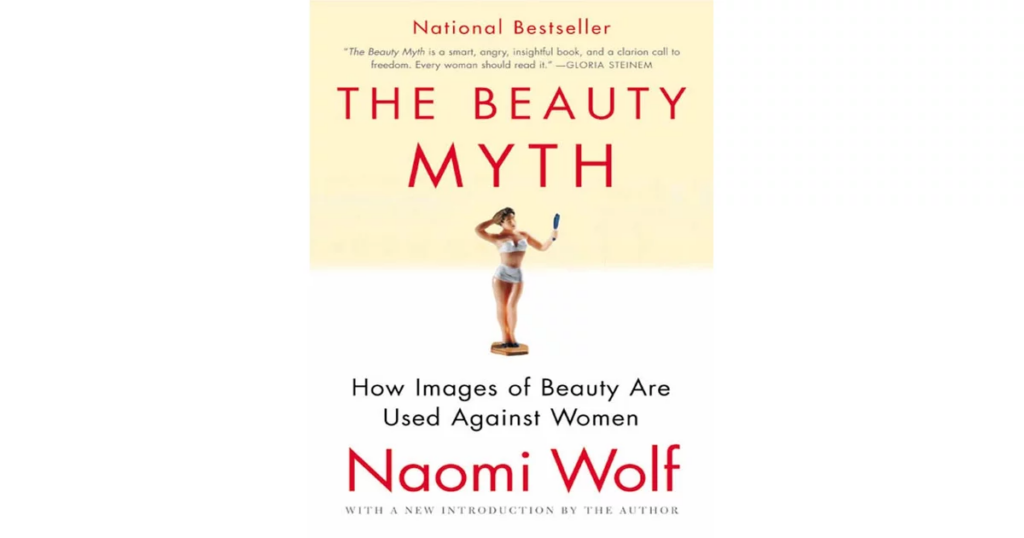
Naomi Wolf is an American author and journalist well known for her contribution to feminist thoughts, particularly through her ground-breaking book The Beauty Myth: How Images of Beauty Are Used against Women (1990) published by Chatto and Windus. Her work aligns with the theoretical framework of Pierre Bourdieu’s concept of symbolic violence which explains how dominant social norms about beauty standards are internalized and reinforced by those they oppress. Additionally, her critique about the commodification of femininity replicates Judith Butler’s theory of gender performativity, which argues how gender roles are constructed through repeated performance. The book also shares similarities with Susan Bordo’s Unbearable Weight (1993), which highlights how women’s bodies have been disciplined through cultural expectations. While Susan Bordo provides a more nuanced analysis of body and mind connection, Wolf’s engaging and handy text and her work are more interesting to the audience.
In this landmark work, she critiques how societal beauty standards have oppressed women’s autonomy and self-worth. The book explores how these stereotypical ideals have evolved and have continued to shape women’s lives in contemporary society. The author’s central argument Is that the beauty myth serves as a new way through which the patriarchal society, restricts women’s opportunity and reinforces gender inequality. She compares the pressure to conform to the beauty ideals to a medieval torture device ‘’The iron maidan’ arguing that societal expectations regarding female appearance serve as modern mechanisms of oppression. Women’s preoccupation with beauty fuels a billion-dollar industry,[i] reinforcing consumerism while keeping women distracted from business, politics, and leadership roles. She also outlined the parallel between the past and present societal expectations of women. Wolfs discusses the practices of foot binding which were quite common in ancient China and corsetry in England, illustrating how women’s bodies were manipulated to fit the narrow standard of beauty. Building upon this historical foundation she examines the contemporary exhibition of beauty myth, particularly within media, magazines, and popular culture. She critiques these industries for perpetuating unrealistic beauty ideals which lead to psychological disorders such as eating disorders, dysmorphia and insecurities among women harming their self-esteem.
The author examined how these beauty norms intersect with different social identities like race, class, and gender. Wolfs argue that these beauty norms or standards affect marginalised groups, particularly women of colour, who face extreme discrimination due to the dominance of Eurocentric beauty ideals. The book extends its analysis to other areas of women’s lives, including sexuality, the workplace, and the impact of religious norms. She critiques the normalization of the sexual imagery presentation and workplace biases against women by media who do not conform to these conventional beauty standards. She introduced the concept of Professional Beauty Qualification (PBQ) – the idea that women’s professional success depends on their appearance rather than their skills and qualifications.
After outlining these oppressive standards of beauty, she urges women to spurn the restrictive norms embrace self-acceptance, and work towards dissembling the societal structure that perpetuates the beauty myth. Naomi Wolf’s work remains benchmark in feminist literature offering a strong critique of these social cultural factors that shapes women’s self-image. Her interdisciplinary approach of incorporating historical analysis, media criticism and psychological insights makes this book a landmark in the study of gender and power.
However, while the book provides us with a robust critique of the beauty standards, it could have benefited more from a deeper exploration of intersectionality, particularly regarding age and disability. The author primarily focused on the experiences of middle-class Western women while leaving the gap in the discussion of how beauty norm varies across different cultures and societies. Additionally, while she eventually deconstructed the problem, she lacked the well-outlined strategies for resistance, which could have empowered the reader with a practical solution to challenge the oppressive beauty standards of society and would have strengthened her call for change. At times her argument seems to imply that all women uniformly experience beauty norms. However, gender identity is fluid, and different individuals navigate beauty expectations differently.
Despite this limitation, the book has been highly relevant today, particularly in this area of social media, where beauty ideals continue to evolve and exert influence. The book serves as a key resource for those having an interest in feminist theory, media studies, and gender politics.
References:
Chaudhuri, Maitrayee. (2017). Refashioning India: Gender, Media and a Transformed Public Discourse. Orient Blackswan: Hyderabad.
Long, K. M. (1992). Review of The Beauty Myth: How Images of Beauty are Used Against Women, by N. Wolf. American Periodicals. 2:151–153.
Hekman, S. (1995). Review of Unbearable Weight: Feminism, Western Culture, and the Body; Bodies That Matter: On the Discursive Limits of Sex by S. Bordo & J. Butler. Hypatia. 10(4), 151–157.
[i] This has been in evidence in India post the 1990s. See Maitrayee Chaudhuri’s Refashioning India: Gender, Media and a Transformed Public Discourse. Orient Blackswan: Hyderabad.
***
Shrishti Kumari is pursuing Master’s in Sociology from Banaras Hindu University (BHU). Her research interests include gender studies, digital platforms, and media, with a focus on exploring the intersections of gender, technology, and society.

Awesome https://lc.cx/xjXBQT
Awesome https://lc.cx/xjXBQT
Awesome https://t.ly/tndaA
Very good https://urlr.me/zH3wE5
Very good https://urlr.me/zH3wE5
Very good https://is.gd/N1ikS2
Good https://is.gd/N1ikS2
Very good https://is.gd/N1ikS2
Good https://is.gd/N1ikS2
Good https://is.gd/N1ikS2
Awesome https://is.gd/N1ikS2
Awesome https://is.gd/N1ikS2